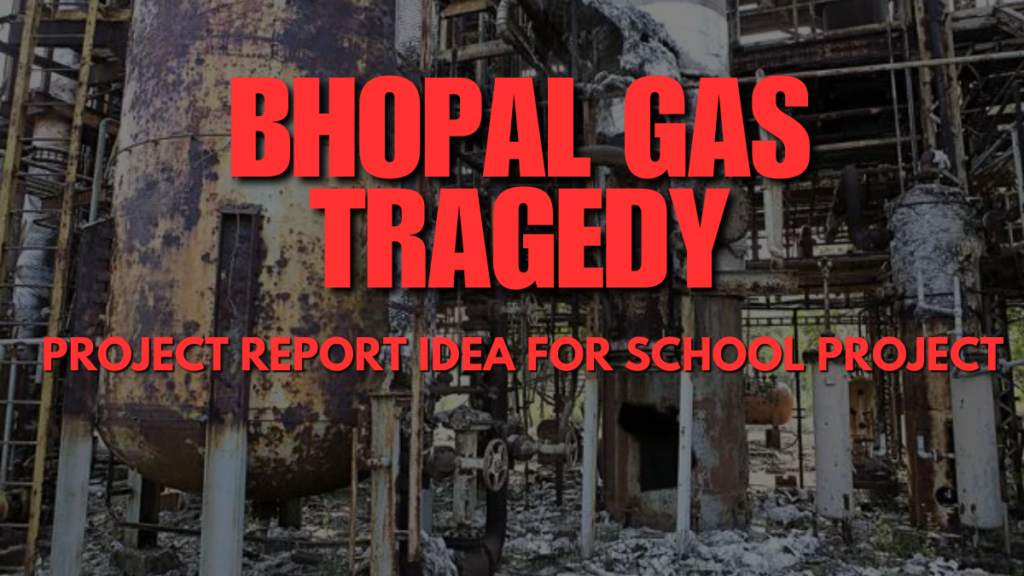The Bhopal Gas Tragedy remains one of the worst industrial disasters in history. It occurred on the night of December 2-3, 1984, in Bhopal, Madhya Pradesh, India, when a gas leak from the Union Carbide India Limited (UCIL) pesticide plant released methyl isocyanate (MIC) gas into the atmosphere. Thousands of lives were lost, and many more were affected by severe injuries and long-term health issues.
A school project on the Bhopal Gas Tragedy offers an opportunity to explore the event, its causes, consequences, and lessons learned. This article provides a detailed outline for creating a comprehensive project report, including structured sections, key points, and visual aids such as tables.
Objectives of the Project
- To understand the causes and consequences of the Bhopal Gas Tragedy.
- To analyze the safety lapses that led to the disaster.
- To learn about the long-term impact on health, the environment, and legal proceedings.
- To explore preventive measures for avoiding similar disasters.
Causes of the Tragedy
The Bhopal Gas Tragedy was caused by a combination of technical, operational, and managerial failures. The primary reasons are listed below:
| Cause | Description |
|---|---|
| Poor Maintenance | Leaking pipes and faulty safety equipment were left unrepaired for months. |
| Safety Negligence | Key safety systems, such as the refrigeration system and vent gas scrubber, were non-operational. |
| Water Contamination | Water entered the MIC storage tank, triggering a runaway chemical reaction. |
| Lack of Training | Workers were not adequately trained to handle emergencies. |
| Cost-Cutting Measures | Reduction in operational costs led to compromised safety standar |
Also Check – Square root maths working model
Immediate Impact
The immediate effects of the gas leak were catastrophic. The toxic cloud spread across Bhopal, affecting thousands of residents. The table below summarizes the immediate impact:
| Aspect | Details |
| Death Toll | Estimated 2,000-3,000 deaths within the first 48 hours. |
| Health Effects | Severe respiratory issues, eye irritation, and chemical burns. |
| Environmental Damage | Contamination of soil and water sources. |
| Evacuations | Thousands fled their homes in panic. |
Long-Term Consequences
The disaster had long-term health, environmental, and socio-economic consequences:
Health Effects
- Chronic Illnesses: Respiratory problems, cancer, neurological disorders, and vision loss.
- Genetic Disorders: Birth defects and developmental issues in children born after the disaster.
Environmental Impact
- Contaminated Soil and Water: Toxic chemicals seeped into the ground, affecting agriculture and drinking water.
- Loss of Biodiversity: The toxic environment harmed local flora and fauna.
Economic and Social Impact
- Economic Losses: Loss of livelihoods and increased healthcare expenses.
Legal and Ethical Issues
The legal battle for justice continues decades after the tragedy. Union Carbide Corporation (now owned by Dow Chemical) faced lawsuits and public outrage. Key legal and ethical issues include:
| Issue | Details |
| Inadequate Compensation | Victims received minimal financial aid, insufficient for long-term rehabilitation. |
| Corporate Accountability | UCC’s response was criticized for lack of responsibility and delayed action. |
| Regulatory Failures | Weak enforcement of safety and environmental regulations. |
Lessons Learned
The Bhopal Gas Tragedy serves as a grim reminder of the importance of industrial safety and corporate responsibility. Key lessons include:
- Strengthening Safety Standards: Ensuring proper maintenance and functioning of safety equipment.
- Employee Training: Regular training programs for workers on emergency protocols.
- Corporate Accountability: Holding companies accountable for safety violations.
- Stronger Regulations: Implementing strict environmental and industrial safety laws.
Preventive Measures
To prevent similar disasters, industries and governments must adopt the following measures:
| Measure | Details |
| Risk Assessment | Conduct regular risk assessments to identify potential hazards. |
| Safety Audits | Perform routine safety audits to ensure compliance with standards. |
| Emergency Response Plans | Develop and regularly update emergency response plans. |
| Community Awareness | Educate nearby communities about potential risks and evacuation procedures. |
Sample Charts and Visuals

Including charts and visuals will make your project more interactive. Here are some examples:
- Timeline of Events: Create a timeline from the plant’s establishment to the aftermath of the disaster.
- Health Impact Pie Chart: Represent the percentage of people affected by various health issues.
- Map of Affected Areas: Highlight the regions most impacted by the gas leak.
Conclusion
The Bhopal Gas Tragedy is a stark reminder of the consequences of negligence in industrial operations. By studying this disaster, we can understand the importance of safety, responsibility, and proactive measures. Your project report should aim to educate and inspire others to prioritize safety and environmental sustainability.
how to make Bhopal gas tragedy project report idea for school project?
A school project on the Bhopal Gas Tragedy offers an opportunity to explore the event, its causes, consequences, and lessons learned. This article provides a detailed outline for creating a comprehensive project report, including structured sections, key points, and visual aids such as tables.
